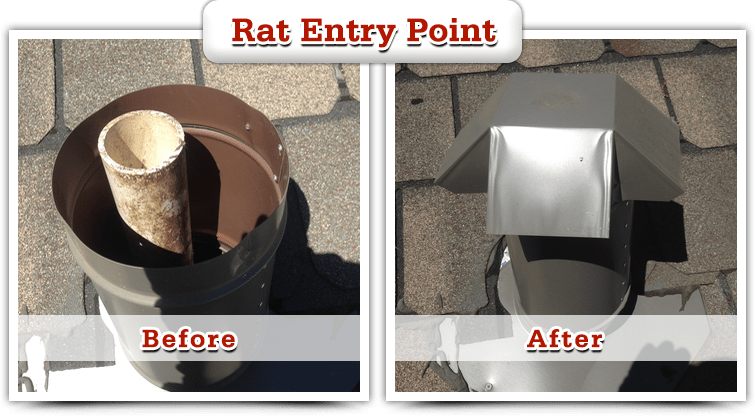Urban Rodents – Rats and Mice
![]() There are two types of rats that typically infest homes in this area. The Roof Rat and the Norway Rat and of course the little house mouse. Contrary to popular belief rats are not stupid. They are smart little creatures that have been around for years
There are two types of rats that typically infest homes in this area. The Roof Rat and the Norway Rat and of course the little house mouse. Contrary to popular belief rats are not stupid. They are smart little creatures that have been around for years
The Roof Rat (Rattus rattus) is known by several names including: ship rat, white bellied rat, gray bellied rat, alexandrine rat and climbing rat. The Roof Rat is a slender rat, more streamlined than the Norway Rat. The hair is generally darker usually with a lighter colored belly. The eyes and ears are larger in proportion to the head and has a pointed nose with a tail that is longer than the body. The droppings on average are .5″ long.


The Norway Rat (Rattus norvegicus) is is known by several names as well; including: brown rat, gray rat, ship rat, wharf rat, sewer rat and the burrowing rat. The Norway rat is more robust and has a stockier appearance than the Roof Rat and weighs a pound or more as an adult. The hair is usually lighter colored and course. The eyes and ears are small and has a blunt nose with a tail that is shorter than the body. The droppings on average are .75″ long. This rat originated in China and has now spread to all continents (except Antartica) and is the dominant rat in Europe and much of North America – making it the most successful mamal on the planet after humans.

The House Mouse has an adult body length (nose to base of tail) of 3 – 4″ and a tail length of 2 – 4″, they weight is typically .35 – .88 oz. They vary from light brown to black with short hair and a light belly. The ears and tail have little hair. The droppings are very small .25″. House mouse droppings are often confused with the droppings of the American Roach. The house mouse is very polific. Females can have litters of 6 every 40-50 days. Indoors, mice will breed year round but outside, they will breed in the spring and fall. Mice have been knows to survive about 6 years, but typically live about a year.
Male mice are territorial, setting up an area which they will guard. The area will contain several females and lower ranking males. Any mouse from another territory will be run out of the area.
It’s important to know the physical capabilities of rats to rat proof your home. Rats will gain entrance thru any opening that is .5″ or larger.
- Both species climb vertical and horizontal wires, pipes, walls
- Both species can climb inside vertical pipes that are only 1.5 to 4″ in diameter
- They can crawl horizontally on any type of pipe or conduit
- Jump vertically as much as 36″ from a flat surface
- Jump horizontally at least 8′ from an elevation of 15″)
- Drop 50′ without being killed or seriously injured
- Burrow vertically in earth to a depth of 4′
- Climb brick or other rough exterior walls that offer footholds, to gain access to upper stories of structures
- Climb vines, shrubs, trees or travel along telephone, cable or power lines to gain access to upper stories of buildings or homes
- Reach as much as 13″ along smooth vertical walls
- Swim as far as .5 mile inopen water, dive through water plumbing traps and travel swer lines even against substantial currents
- Gnaw through a variety of materiels including lead sheeting, sun drived adobe brick, cinder block, aluminum sheeting and lead pipes
Why is it so important to rid your home or office of these vermin? Besides just being disgusting they carry diseases including but not limited to:
- The Plague
- Murine Typus
- Leptospirosis (urine)
- Toxoplasmosis
- Trichinosis (to animals as well as humans)
- Hemorrhagic fever with renal syndrome
- Hantavirus
- Lymphocytic Choriomeningites
- Rat Bite fever (not always spread through actual bite)
- Salmonellosis
Fun Mouse Facts:
- Mice do not have poor eyesight. They can see up to 3 feet. That doesn’t sound like much but think that their world is about 10 feet
- Having mice is not an indication of poor housekeeping. It’s a matter of access. If you don’t address how the mouse got in, you will see more mice.
- Cheese is not the best bait for mice. It’s much better to use seeds, fruits and nuts.
- Mice do not need access to water! Mice are very efficient at keeping their bodies hydrated with the moisture from their food.
It is not only important that you remove the rodents from your home but also that a clean up be done of the droppings and the area be disinfected. As droppings dry and crumble they become aerosolized and can be inhaled by humans causing a variety of health problems.

















